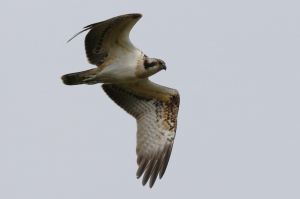Site And Records Information
Several Ospreys will generally pass through the harbour area in spring and individuals may even linger for part of the summer, but they are most easily seen during autumn (Jul-Sept) when up to ten may be present simultaneously during the peak migration time of mid-August to early September. They can then be seen feeding or resting in favoured locations, notably at the back of the Middlebere Channel or the Wareham Channel where two-four may be present together. Alternative day roost sites include Morden Bog (just outside the Harbour boundary), Lytchett Bay, Holton Heath and private grazing land at Keysworth.
Ospreys fish in open water all around the harbour though they are most often seen off the Arne Peninsula or in the Wareham Channel. There are also annual records of birds fishing in Brands Bay and Wytch Lake in addition to all of the above sites.
Several artificial nests were erected within the Harbour in 2010 by the RSPB under the expert guidance of Roy Dennis. It was hoped that nesting would occur in due course but, although birds have been recorded on the nest platforms, no indication of breeding has yet been observed.
The earliest date on record is on 7th Mar 2007 at Arne and the latest is 30th Nov 2001 at Holes Bay. These are also the earliest and latest dates for Dorset.
In July 2017 an Osprey translocation was given the go ahead to take place in Poole Harbour as a first stage in establishing a south coast breeding population of this spectacular bird. The project was led by us, ‘Birds of Poole Harbour’, Scottish charity the ‘The Roy Dennis Wildlife Foundation’ and local Poole based-business ‘Wildlife Windows’. Over a five year period (2017-2021) 60 Osprey chicks will be translocated from Scotland to Poole Harbour in an effort to restore a south coast breeding population.
Ospreys, which feed exclusively on fish, historically bred across the whole of Britain and NW Europe; but populations drastically declined in the Middle Ages and became extinct in England by the mid 1800’s. The five year project looks to restore Ospreys to their former breeding grounds in the south of England where they used to have the local nickname “Mullet Hawk”. At the same time the project will provide an important stepping stone between breeding populations in Britain and northern France, with the aim of enhancing the long term survival of the Western European population as a whole. The project is part of a wider conservation recovery plan of Osprey in Western Europe and the Mediterranean region.
A Conservation Recovery Plan
Ospreys are annual visitors to Poole Harbour as they pass through on their northward and southward migrations between their breeding grounds in Scotland and central England and their over-wintering grounds in West Africa. Over the last 8 years, efforts within Poole Harbour have been made by the RSPB, Natural England, The Forestry Commision, The National Trust and private landowners to try and attract Osprey to stay and breed by erecting artificial nesting platforms in the hope that the birds will adopt them as their own nests. Osprey are semi-colonial and often choose to nest in areas where other Osprey are nesting and in 2009, the RSPB went as far as placing decoy birds, supplied by Roy Dennis, on one of their nesting platforms on their Arne Reserve. Although there has been some interest by Osprey in these nesting platforms over that 8 year period, none have decided to stay and breed and it’s now thought a translocation project is the next logical step to try and encourage these incredible birds of prey to settle on the south coast of England.
Previous Restoration Success
Translocation has proved a highly successful means by which to restore ospreys to areas from which they have been lost. The much-admired population at Rutland Water in the East Midlands was established by a pioneering translocation project in the late 1990s and similar work has since taken place in two regions of Spain as well as in Italy, Portugal and Switzerland.
This pan-European experience means that the Poole Harbour project, which will involve licensed collection of five-six week-old chicks from healthy, sustainable populations in Scotland, has the best-possible chance of success. Once collected the chicks will be safely brought down to Poole Harbour and held in large holding pens at a confidential site for just two – three weeks to acclimatise to their new home and prepare for their first flights. Once released they will be provided with fresh fish on artificial nests, to replicate normal osprey behaviour, and so are likely to remain around Poole Harbour for a further six weeks (the normal post-fledging period) before beginning their long migration to West Africa. During this six week period the birds will imprint on the area and adopt Poole as their new home.
Breeding
In 2022, the first breeding of Osprey in southern Britain for 200 years was achieved as a direct result of the Translocation that the Birds of Poole Harbour and Roy Dennis Wildlife Foundation carried out. Osprey pair CJ7 (female) and 022 (male) nested at a confidential site in the Piddle Valley and successfully fledged 2 juvenile female Ospreys. These chicks were ringed 5H1 and 5H2. Sadly, almost a month after fledging, 5H2 was taken by a juvenile Goshawk at the nest site. Thankfully 5H1 successfully migrated away in late August 2022.
In 2023 the adult pair CJ7 and 022 safely returned from West Africa to their nest site in the Piddle Valley and began nest building straight away. The 2023 season was far more successful with 3 chicks being produced, ringed 5H3 (male), 5H4 (male) and 5H5 (female) all of which successfully migrated from the harbour at the end of August 2023.
Osprey – Brands Bay – Peter Moore
